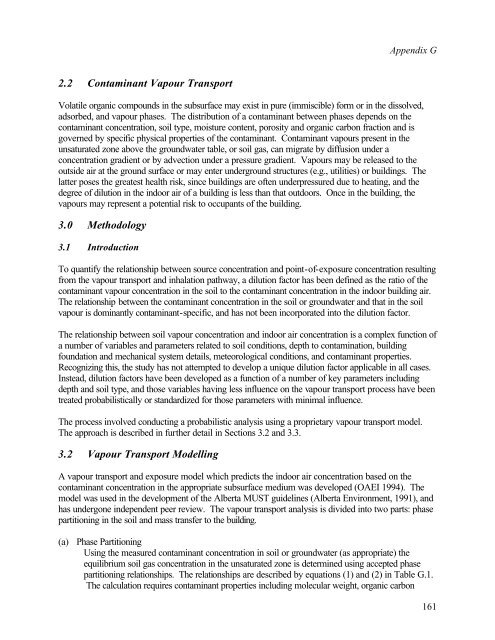Protocol for the Derivation of Environmental and Human ... - CCME
Protocol for the Derivation of Environmental and Human ... - CCME
Protocol for the Derivation of Environmental and Human ... - CCME
You also want an ePaper? Increase the reach of your titles
YUMPU automatically turns print PDFs into web optimized ePapers that Google loves.
Appendix G<br />
2.2 Contaminant Vapour Transport<br />
Volatile organic compounds in <strong>the</strong> subsurface may exist in pure (immiscible) <strong>for</strong>m or in <strong>the</strong> dissolved,<br />
adsorbed, <strong>and</strong> vapour phases. The distribution <strong>of</strong> a contaminant between phases depends on <strong>the</strong><br />
contaminant concentration, soil type, moisture content, porosity <strong>and</strong> organic carbon fraction <strong>and</strong> is<br />
governed by specific physical properties <strong>of</strong> <strong>the</strong> contaminant. Contaminant vapours present in <strong>the</strong><br />
unsaturated zone above <strong>the</strong> groundwater table, or soil gas, can migrate by diffusion under a<br />
concentration gradient or by advection under a pressure gradient. Vapours may be released to <strong>the</strong><br />
outside air at <strong>the</strong> ground surface or may enter underground structures (e.g., utilities) or buildings. The<br />
latter poses <strong>the</strong> greatest health risk, since buildings are <strong>of</strong>ten underpressured due to heating, <strong>and</strong> <strong>the</strong><br />
degree <strong>of</strong> dilution in <strong>the</strong> indoor air <strong>of</strong> a building is less than that outdoors. Once in <strong>the</strong> building, <strong>the</strong><br />
vapours may represent a potential risk to occupants <strong>of</strong> <strong>the</strong> building.<br />
3.0 Methodology<br />
3.1 Introduction<br />
To quantify <strong>the</strong> relationship between source concentration <strong>and</strong> point-<strong>of</strong>-exposure concentration resulting<br />
from <strong>the</strong> vapour transport <strong>and</strong> inhalation pathway, a dilution factor has been defined as <strong>the</strong> ratio <strong>of</strong> <strong>the</strong><br />
contaminant vapour concentration in <strong>the</strong> soil to <strong>the</strong> contaminant concentration in <strong>the</strong> indoor building air.<br />
The relationship between <strong>the</strong> contaminant concentration in <strong>the</strong> soil or groundwater <strong>and</strong> that in <strong>the</strong> soil<br />
vapour is dominantly contaminant-specific, <strong>and</strong> has not been incorporated into <strong>the</strong> dilution factor.<br />
The relationship between soil vapour concentration <strong>and</strong> indoor air concentration is a complex function <strong>of</strong><br />
a number <strong>of</strong> variables <strong>and</strong> parameters related to soil conditions, depth to contamination, building<br />
foundation <strong>and</strong> mechanical system details, meteorological conditions, <strong>and</strong> contaminant properties.<br />
Recognizing this, <strong>the</strong> study has not attempted to develop a unique dilution factor applicable in all cases.<br />
Instead, dilution factors have been developed as a function <strong>of</strong> a number <strong>of</strong> key parameters including<br />
depth <strong>and</strong> soil type, <strong>and</strong> those variables having less influence on <strong>the</strong> vapour transport process have been<br />
treated probabilistically or st<strong>and</strong>ardized <strong>for</strong> those parameters with minimal influence.<br />
The process involved conducting a probabilistic analysis using a proprietary vapour transport model.<br />
The approach is described in fur<strong>the</strong>r detail in Sections 3.2 <strong>and</strong> 3.3.<br />
3.2 Vapour Transport Modelling<br />
A vapour transport <strong>and</strong> exposure model which predicts <strong>the</strong> indoor air concentration based on <strong>the</strong><br />
contaminant concentration in <strong>the</strong> appropriate subsurface medium was developed (OAEI 1994). The<br />
model was used in <strong>the</strong> development <strong>of</strong> <strong>the</strong> Alberta MUST guidelines (Alberta Environment, 1991), <strong>and</strong><br />
has undergone independent peer review. The vapour transport analysis is divided into two parts: phase<br />
partitioning in <strong>the</strong> soil <strong>and</strong> mass transfer to <strong>the</strong> building.<br />
(a) Phase Partitioning<br />
Using <strong>the</strong> measured contaminant concentration in soil or groundwater (as appropriate) <strong>the</strong><br />
equilibrium soil gas concentration in <strong>the</strong> unsaturated zone is determined using accepted phase<br />
partitioning relationships. The relationships are described by equations (1) <strong>and</strong> (2) in Table G.1.<br />
The calculation requires contaminant properties including molecular weight, organic carbon<br />
161
















